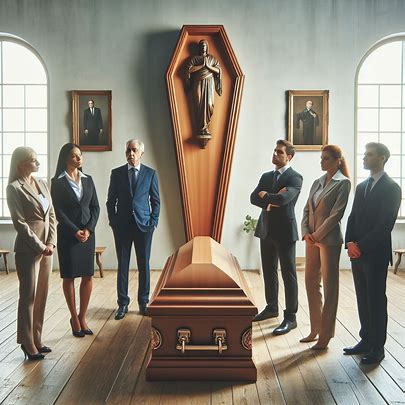
Coffins vs. Caskets: The Key Differences
When it comes to saying our final goodbyes, the choices can be overwhelming. Coffins and caskets, often used interchangeably, actually present subtle differences that reflect personal preferences and historical traditions. Let’s delve into the details to unravel the mysteries behind these burial containers.
While both coffins and caskets serve the solemn purpose of housing the deceased, they differ in several key ways. Gravelisting provides a guidelines about coffins and casket and the brief history.
Understanding Coffins: A Tapered Shape
Coffins, with their tapered shape, hearken back to ancient times. The design, wider at the shoulders and narrower at the head and foot, mirrors the natural contours of the human body. Historically made from wood, coffins traditionally lack exterior handles, with any embellishments referred to as “coffin furniture.” The six-sided structure and removable lids, showcasing a blend of simplicity and functionality, make coffins a choice for those inclined towards a more traditional and economical approach.
Decoding Caskets
On the other side of the spectrum, we have caskets, known for their rectangular shape and often constructed with high-quality materials like stainless steel or wood. Caskets come with hinged lids, providing a more elegant and elaborate presentation. The rectangular design signifies a departure from the tapered shape, creating a distinct visual impression. Caskets, while more expensive, offer a range of decorative elements, catering to those who seek a visually refined farewell.
Historical Roots: Coffins Through the Sands of Time
Coffins have been used for centuries as a way to preserve and protect the remains of the deceased. The history of coffins can be traced back to ancient times, where early forms of coffins were made from burlap sacks. Over time, the design and materials used to create coffins have evolved, reflecting the changing attitudes towards death and dying.
Ancient Beginnings
The earliest forms of coffins were simple pits in the sandy desert, at the edge of the Nile floodplain, dating back to about 4400-3200 BC. The dead were laid on their sides in a fetal position, wrapped in linen, and placed in shallow pits
As time passed, the design of coffins evolved, with the Renaissance period witnessing the crafting of coffins from solid wood, often reserved for the wealthier families. This historical journey reflects the evolution of burial practices and the significance attached to preserving and protecting the remains.
Egyptian Influence
The traditional coffin, with its origins traced to ancient Egypt around 2500 B.C., played a pivotal role in preserving and transporting the deceased for their afterlife journey. Ornate designs, intricate carvings, and even the use of solid gold showcased the cultural and religious significance attached to these burial containers
Egyptian coffins were often made of wood, with the most elaborate coffins made of solid gold. The coffins were often decorated with intricate carvings and hieroglyphics, depicting the life of the deceased and their journey to the afterlife. The use of gold and other precious materials reflected the wealth and status of the deceased
Roman Influence
The Romans also had their own unique approach to coffins. Lead caskets were used to transport the remains of the deceased, with some even decorated with Celtic motifs. The lead in the caskets had become warped and misshapen over time, causing their covers to become dislodged, and the caskets filled up with sand and earth
Contemporary Choices: From Materials to Personalization
Materials Matter:
Today, coffins and caskets are available in a myriad of materials, ranging from wood and metal to eco-friendly options like cardboard or wicker. Considerations for environmental impact and personal preferences guide the choice of material, ensuring a diverse array of options to suit individual needs.
Personal Touch:
Personalization takes center stage as families seek to add unique elements to the final resting place. From handles and trimmings to engravings and even colorful or picture coffins, the choices allow for a personalized farewell that reflects the individuality of the departed.
Considerations for Families
Environmental Concerns:
Deciding between a coffin and a casket often involves considering the type of service – burial or cremation – and environmental concerns. Eco-friendly options, such as biodegradable coffins, have gained popularity as individuals seek more sustainable choices for their final journey.
Size and Personalization:
Selecting the right size and personalization details further enhance the farewell experience. Understanding the dimensions based on the individual’s height and weight ensures a proper fit. Personal touches, whether in the form of engraved messages or customized handles, contribute to a meaningful and unique farewell.
Memorials and Pallbearers
Symbols and Memorials:
Coffins and caskets serve as a canvas for symbols and memorials. Nameplates, religious symbols, and cultural elements can be added to personalize the final resting place. Memorials, ranging from headstones to simple flowers, provide a tangible way for loved ones to remember and pay respects.
Pallbearer Etiquette:
The role of pallbearers, tasked with carrying the coffin, involves a delicate responsibility. Whether carrying it at waist height or using a small trolley, understanding the etiquette ensures a respectful and dignified farewell.
Conclusion: A Personal Farewell
In the end, the choice between a coffin and a casket transcends the physical container; it becomes a reflection of personal values, traditions, and the unique journey of the departed. Whether steeped in historical roots or embracing modern personalization, these burial containers guide us through the delicate process of saying goodbye. In this tapestry of choices, what matters most is that the farewell is as individual and meaningful as the life it honors.

